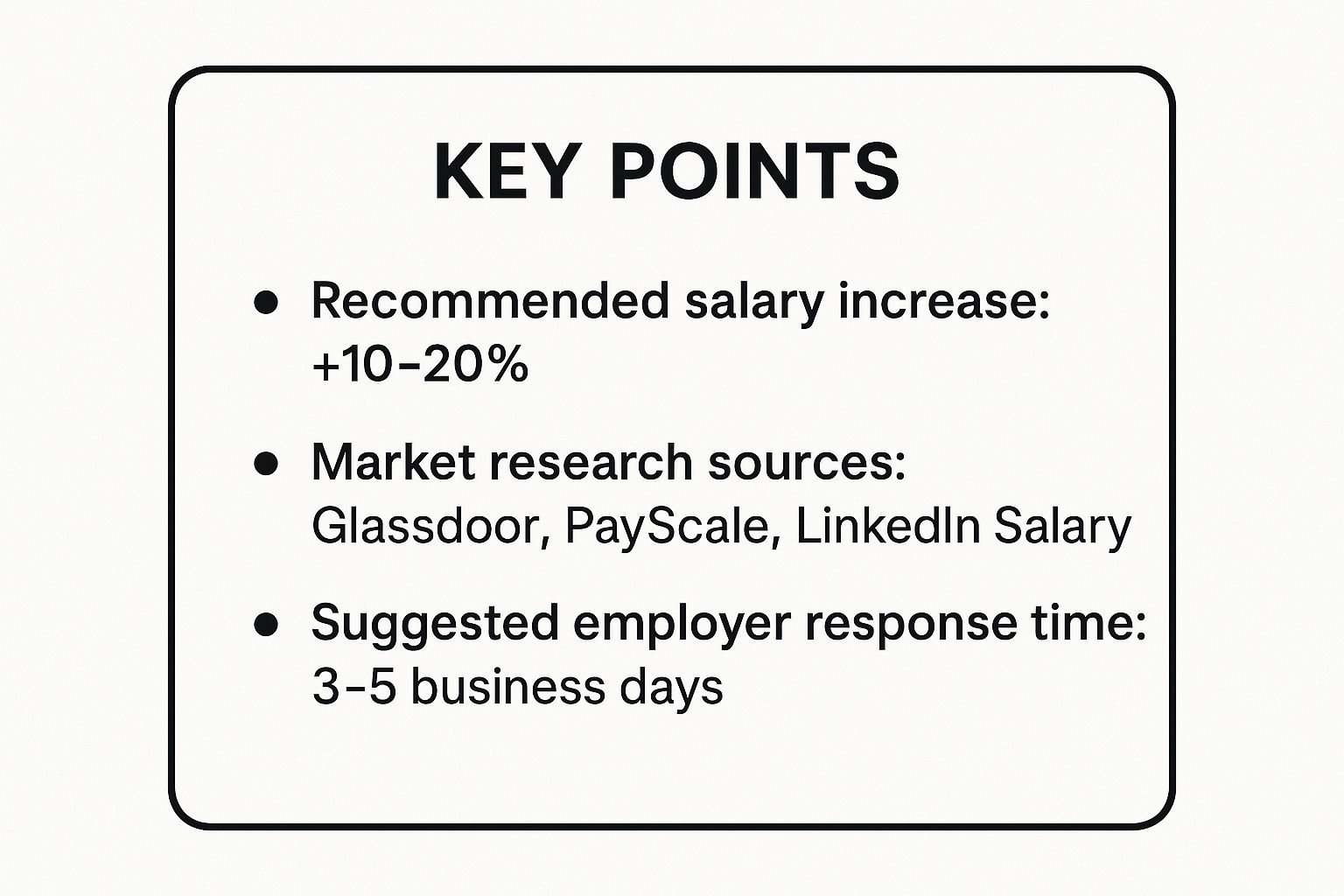Top Counter Offer Letter Examples to Boost Your Salary in 2025

You've landed the job offer—congratulations! But the negotiation isn't over. The initial offer is just a starting point, and a well-crafted counter can significantly increase your compensation, improve your benefits, and set you up for long-term success. Many professionals hesitate, fearing it might jeopardize their chances. However, most employers expect a negotiation and see it as a sign of confidence and an understanding of your market value.
This guide provides seven distinct counter offer letter examples, each tailored to a specific scenario you might face. We'll break down the strategy behind each template, providing actionable analysis and key takeaways to help you craft a compelling response. Whether you're focused on base salary, a better benefits package, or leveraging a competing offer, these examples will give you the framework to negotiate with data-driven confidence and secure the terms you deserve. Let's get started.
1. The Salary-Focused Counter Offer Letter
This is the most common and direct type of negotiation letter. A salary-focused counter offer letter aims squarely at increasing the base compensation by presenting a data-backed argument. This approach is most effective when you are confident that the initial offer is below the market rate for your skills, experience, and the role's geographic location.
How It Works
The strategy is simple: you express genuine enthusiasm for the position and the company, then pivot to a polite but firm request for a higher salary. The key to success is providing concrete evidence to justify your request. This isn’t about what you want; it’s about what your value is in the current job market. For instance, a software engineer might use regional salary surveys to argue for a jump from an initial offer of $95,000 to a market-aligned $115,000.
Key Tactics and Takeaways
To build a compelling case, your letter must be well-researched and professional. Here are the core components of one of the most effective counter offer letter examples:
- Start with Gratitude: Always begin by thanking the hiring manager for the offer and reiterating your excitement about the opportunity.
- Present Your Data: Clearly state your desired salary and immediately support it with market data from reputable sources like Glassdoor, PayScale, or LinkedIn Salary.
- Justify Your Value: Connect the market data to your specific qualifications. Briefly mention 2-3 key accomplishments or skills that prove you are a top-tier candidate worth the investment.
- Maintain a Collaborative Tone: Frame the negotiation as a mutual goal to find a number that works for both sides, rather than a demand.
The infographic below summarizes the key data points for structuring your salary-focused negotiation.

These figures provide a solid framework, guiding you to a reasonable request backed by industry-standard research and a professional timeline.
2. The Comprehensive Benefits Package Counter Offer Letter
This counter offer letter takes a holistic approach by negotiating multiple components of the compensation package beyond base salary. This approach is particularly effective when a company indicates limited flexibility on salary but can adjust other benefits. It focuses on the total value of the offer, not just the paycheck.

How It Works
The strategy is to demonstrate flexibility by focusing on non-salary items that are valuable to you and potentially lower cost for the employer. You show enthusiasm for the role but explain that the total compensation package needs slight adjustments to align with your expectations. For example, instead of a $10,000 salary increase, a marketing manager might request an additional week of vacation and a $5,000 signing bonus to bridge the gap.
Key Tactics and Takeaways
To succeed with one of the most strategic counter offer letter examples, you must present your requests as reasonable, well-thought-out alternatives.
- Prioritize Your Needs: Identify the top 2-3 benefits that matter most, such as remote work flexibility, a professional development budget, or more paid time off.
- Show Flexibility: Frame your requests as options. For instance, you could state, "If the base salary is firm, I would be happy to move forward if we could add a $2,000 home office stipend and a remote work arrangement three days a week."
- Calculate the Value: Understand the monetary value of what you’re asking for. An extra week of vacation or better health insurance can be worth thousands of dollars.
- Be Specific: Instead of vague requests, ask for concrete items. For example, ask for a six-month performance review with a clear path to a raise, rather than just "more opportunities for growth."
3. The Competing Offer Counter Letter
This is a high-stakes, high-reward negotiation tactic. The competing offer counter letter leverages a firm offer from another company to increase the value of the one you prefer. This approach is most effective when you have a legitimate, comparable offer in hand and can tactfully communicate your market value without sounding like you are issuing an ultimatum. It signals to the employer that your skills are in high demand.
How It Works
The strategy involves transparently, yet diplomatically, informing the hiring manager about your other offer. You express a strong preference for their company, but explain that the competing terms have created a difficult decision. This forces them to re-evaluate their initial offer against a tangible benchmark. For instance, a marketing director with an offer for $150,000 can use a competing offer of $165,000 plus a signing bonus to negotiate a revised package that meets or exceeds those terms.
Key Tactics and Takeaways
To execute this successfully, your letter must be a masterclass in professional poise. Here are the core components of one of the most powerful counter offer letter examples:
- Reaffirm Strong Interest: Begin by reiterating your genuine excitement and stating that their company is your top choice. This frames the negotiation as a problem-solving effort, not a threat.
- Introduce the Competing Offer: Clearly and concisely state that you have received another offer. Mention specific, compelling terms (like a higher salary or better benefits) without being boastful.
- State Your Goal Clearly: Explicitly ask if they can match or improve upon the competing offer. Propose specific figures or terms you would need to confidently accept their position.
- Set a Respectful Timeline: Provide a reasonable deadline for their response, acknowledging that you must also respond to the other company. This creates a sense of urgency without being aggressive.
4. The Career Growth and Development Counter Offer Letter
This forward-thinking approach prioritizes long-term career trajectory over immediate compensation. A career growth and development counter offer letter negotiates for things like clear promotion timelines, professional development funding, mentorship programs, or expanded responsibilities. This strategy is particularly effective for early-career professionals or those making a strategic move where future potential outweighs the initial salary.
How It Works
The goal is to secure a commitment from the employer to invest in your professional growth. You convey your excitement for the role, then propose specific, non-monetary terms that will enhance your skills and advance your career within the company. For example, a marketing coordinator might accept the offered salary but request a written 18-month timeline for promotion to a manager role, contingent on meeting specific performance metrics. This shifts the focus from "what you'll pay me now" to "how we'll grow together."
Key Tactics and Takeaways
To make this type of negotiation successful, your requests must be specific, measurable, and aligned with company goals. These are the core elements of one of the most strategic counter offer letter examples:
- Express Long-Term Commitment: Start by emphasizing your enthusiasm for the role and your desire to build a long-term career with the company.
- Propose Specific Opportunities: Clearly outline what you are asking for. Instead of a vague request for "growth," ask for a specific certification budget (e.g., $2,000 for an AWS certification), a formal mentorship with a senior leader, or the lead role on a specific upcoming project.
- Define Timelines and Metrics: Attach measurable outcomes and timelines to your requests. Propose a performance review at nine months with formal promotion consideration or specific criteria that would trigger a title change.
- Frame it as a Mutual Benefit: Position your requests as an investment that will deliver greater value to the company. Your new skills or expanded responsibilities will directly contribute to the team's success. More information on how this framework operates can be found in our comprehensive guides about how career growth impacts compensation.
5. The Work-Life Balance Counter Offer Letter
This increasingly popular counter offer letter prioritizes flexibility, autonomy, and well-being over purely financial gains. It focuses on negotiating elements like remote work, flexible hours, or additional vacation time. This approach is powerful when the salary is competitive but the role’s structure could be improved to better suit your lifestyle and productivity needs.

How It Works
The strategy involves framing your request around mutual benefit. You show enthusiasm for the role and then propose specific, non-monetary adjustments that will enhance your productivity and commitment. The goal is to demonstrate that a more flexible arrangement will allow you to deliver exceptional results. For example, a candidate might negotiate for a permanent remote-work agreement, saving them a long commute and allowing for more focused work time, which directly benefits the employer.
Key Tactics and Takeaways
To succeed with these types of counter offer letter examples, you must be specific, proactive, and outcome-oriented. Your letter should address potential concerns before they are even raised.
- Propose a Concrete Plan: Don't ask for vague "flexibility." Instead, request a specific arrangement, such as "a hybrid model with remote work on Mondays and Fridays."
- Focus on Productivity: Explain how your proposed schedule will maintain or even improve your performance and availability. Reassure them about collaboration and communication.
- Suggest a Trial Period: Offer a 3-month trial of the new arrangement. This low-risk proposal demonstrates confidence and makes it easier for the employer to say yes.
- Frame it as a Win-Win: Position your request not as a personal convenience but as a strategic way to ensure you are a focused, productive, and long-term employee.
6. The Relocation-Focused Counter Offer Letter
This specialized counter offer addresses the significant financial and logistical hurdles of moving for a job. It aims to negotiate a comprehensive relocation package that covers not just moving boxes, but the entire transitional experience. This approach is essential for roles requiring a geographic move, especially to a high-cost-of-living area where initial expenses can be substantial.
How It Works
The strategy involves framing the relocation not as a personal inconvenience, but as a business-critical investment the company must make to secure your talent. You express strong interest in the role while clearly outlining the specific financial support needed for a smooth transition. For example, an executive moving cross-country might negotiate for temporary corporate housing, coverage for house-hunting trips, and spousal career assistance, ensuring they can be productive from day one without personal financial strain.
Key Tactics and Takeaways
To secure a robust relocation package, your request must be detailed, well-researched, and professionally presented. The best counter offer letter examples for relocation include these elements:
- Express Enthusiasm First: Start by reaffirming your excitement for the position and your commitment to making the move.
- Itemize Your Needs: Instead of a vague request, list specific needs like moving expenses, a lump-sum payment for incidentals, temporary housing for 30-60 days, and travel costs for a house-hunting trip.
- Justify with Data: If moving to a more expensive city, use a cost-of-living calculator to request a salary adjustment. You can learn more about salary data in different locations to build your case.
- Clarify the Details: Ask important questions about tax implications (is the package "grossed-up" to cover taxes?) and any repayment clauses if you leave the company within a certain period.
7. The Internal Promotion Counter Offer Letter
This unique counter offer is for employees negotiating a promotion within their current company. An internal promotion counter offer letter leverages your proven track record and institutional knowledge to justify compensation that aligns with the new role's increased responsibilities, rather than just an incremental raise on your current salary. The tone must carefully balance loyalty and appreciation with firm advocacy for fair, market-rate compensation.
How It Works
The strategy involves reframing the conversation from a simple pay bump to a re-evaluation of your value based on the new position’s external market rate. You express gratitude for the internal opportunity, then present a well-researched case demonstrating the gap between the offer and what a new external hire would command for the same role. For example, a senior analyst offered a manager role at $75,000 could use market data to negotiate for a salary of $95,000, which reflects the standard for that management level.
Key Tactics and Takeaways
To succeed, you must shift the focus from your past salary to your future value. These key components are vital for effective internal counter offer letter examples:
- Acknowledge the Opportunity: Start by sincerely thanking management for their trust and the promotion, reaffirming your commitment to the company.
- Focus on the New Role: Frame your negotiation around the market value of the new position. Use external data to support your request. You can explore a salary guide to learn more about market rates for specific roles.
- Leverage Your Internal Value: Highlight your proven contributions and how your existing knowledge of company systems and culture reduces the risk and cost associated with an external hire.
- Propose a Solution: Clearly state your desired salary or title adjustment, presenting it as a way to align your new compensation with the role's responsibilities and market standards.
7 Key Counter Offer Letter Types Comparison
| Counter Offer Type | Implementation Complexity 🔄 | Resource Requirements ⚡ | Expected Outcomes 📊 | Ideal Use Cases 💡 | Key Advantages ⭐ |
|---|---|---|---|---|---|
| The Salary-Focused Counter Offer Letter | Low – straightforward, focused on salary negotiation | Moderate – requires market research and data collection | Clear salary adjustment or rejection | When salary is primary negotiation point | Direct, data-backed, professional approach |
| The Comprehensive Benefits Package Counter Offer Letter | High – negotiates multiple components, involves trade-offs | High – needs detailed package calculations and approvals | Holistic compensation improvement | When salary is inflexible but benefits are negotiable | Flexible options, may yield better overall package |
| The Competing Offer Counter Letter | Moderate – requires careful wording and timing | Moderate – must have an actual competing offer | Improved offer with potential urgency | When holding genuine competing offers | Strong leverage, validates market value |
| The Career Growth and Development Counter Offer Letter | Moderate – focuses on non-monetary negotiations | Low to moderate – focused on development opportunities | Long-term career path clarity and advancement | Early-career professionals or strategic career movers | Shows ambition, aligns goals, often low cost for employer |
| The Work-Life Balance Counter Offer Letter | Low to moderate – negotiates flexible arrangements | Low – mostly non-financial resource adjustments | Improved work-life satisfaction | When flexibility and well-being are priorities | Low cost, enhances satisfaction and retention |
| The Relocation-Focused Counter Offer Letter | High – complex logistics and multiple expense items | High – involves significant financial and logistical resources | Comprehensive relocation support | When position requires geographic move | Addresses major financial burden, practical support |
| The Internal Promotion Counter Offer Letter | Moderate – requires market data and internal advocacy | Moderate – internal salary ranges and market comparison needed | Fair compensation reflecting new role | When negotiating terms for an internal promotion | Leverages existing track record, faster negotiation |
Negotiate with Confidence and Data
Navigating a job offer is a pivotal career moment, and crafting a thoughtful counter offer letter is your opportunity to advocate for your true market value. The diverse counter offer letter examples explored in this guide, from salary-focused requests to those centered on career growth or work-life balance, all share a common foundation: they are strategic, professional, and built on a bedrock of credible evidence.
The most effective negotiations are never based on emotion or demand. Instead, they are conversations grounded in mutual respect and supported by objective data. Your success hinges on your ability to clearly articulate your value proposition, backed by market research, specific achievements, and a clear understanding of what you need to thrive professionally. This preparation transforms your counter offer from a simple request into a compelling business case for a revised offer.
Remember these core principles as you prepare your response:
- Anchor in Data: Always use reliable market salary data, the specifics of a competing offer, or quantifiable metrics of your past performance to justify your requests. This removes subjectivity and strengthens your position.
- Maintain Professionalism: Your tone should remain enthusiastic, appreciative, and collaborative throughout the process. You are building a potential partnership, not winning a battle.
- Be Specific and Prioritized: Clearly state what you are asking for, whether it’s a specific salary figure, an additional week of vacation, or a defined professional development budget. Knowing your priorities helps guide the negotiation toward a successful outcome.
Mastering the art of the counter offer is more than just securing better compensation; it is a demonstration of your strategic thinking, communication skills, and professional confidence. By leveraging these templates and grounding your approach in solid data, you are not just negotiating a salary-you are setting the stage for your future success and establishing your value from day one.
Ready to build an undeniable case for your counter offer? Stop guessing your worth and start negotiating with verified data. Explore SalaryGuide to access thousands of real, role-specific salary benchmarks and ensure your request is perfectly aligned with the market. Get the data you need at SalaryGuide.
Article created using Outrank